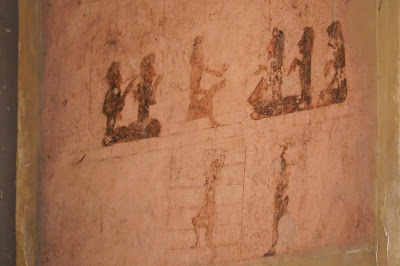The Temple of St Bernard and the Sisal Convent
We are now in Valladolid, the third largest city of Yucutan State (third by a long way with a population of 45,000 compared to Mérida's 1m). The city was originally founded in 1543 on a site to the north of its current location, but had to be relocated because of mosquitoes. Francisco de Montejo conquered the Mayan city of Zaci, demolished it and built his new city on the site. Like Merida it has a central square and a grid pattern of streets. And also like Mérida it is named for a city in Spain, which was at that time the capital.
Armed with a very useful map and briefing from our hotel, we headed along Calle 40 towards the centre. This was the view ahead. We quickly realised one common stylistic feature: the hood mouldings above the doors and windows as well as the colourful facades that we saw in Mérida.
On reaching the main square we immediately made a detour to the right (Calle 41) to see the Museo de San Roque (a museum of regional history). It was once a hospital.
It was a bit old-fashioned inside and all in Spanish, but there was a marvelous crucifix.
We continued our detour to see the charming Municipal market where bought some avocados.
Returning to the main square we admired the facade of the Cathedral de San Gervasio. The original church was built using the stones of the main pyramid in 1545, but it was demolished and rebuilt in the early 1700s. It is the only church
with a north-facing entrance in the Yucatán.
At this point we heard a commotion of car horns and sirens. It was yet another of the innumerable parties of pilgrims we have seen over the time we have been here. Small groups of mainly young men make a pilgrimage to the various shrines of Our Lady of Guadalupe. The cult began in Spain in the 14th century and was introduced into Mexico after 1531 when the Virgin appeared to a man named Juan Diego telling him to build a church in her honour. You can read the full story on
Wikipedia. For present purposes, the key point is that the feast day is tomorrow, 12 December. Here is a typical group with the Town Hall (the Palao Municipal) behind.
The main interest of the Town Hall is a group of four lively paintings in a gallery on the top floor which depict the history of the city, starting with the pre-Conquest Mayan period, followed by the Spanish Conquest, the civil war of the 19th century and the revolution of 1910. Here is the Conquest painting.
Continuing to the north side of the square we admired another market (actually a modern construction) and a Spanish colonial style house which now contains a reasonable restaurant.
On the same side of the square is another nice pair of houses, the one on the left seems to be a Spanish colonial dwelling which has been unaltered, at least externally.
We headed along Calle 42 and returned along Calle 40, passing several more attractive buildings. Like the hood moulding, I think the pilasters are modern.
We now left the town centre and walked along the picturesque - and very well restored - Clazade de los Frailes ...
... to reach, at the end, the (former) Convent of Sisal and the adjoining church of San Bernadino di Sienna. They were built between 1552 and 1560. The convent was rather battered looking, the central cloister looked in bad shape - as well as being architecturally very dour.
We emerged outside to see this interesting structure in the garden. It is a water wheel built in 1613 above a cenote to provide water for the convent.
The church, was light and spacious with a long nave, with some nice vaulting at the end.
Outside, one the most striking, and uncomfortable, features, was the remains of the external chapel where Mayan converts were able to hear Mass - they were not allowed inside the church.
Conditions: hot.
Distance: maybe 3 miles.
Rating: four and a half stars. Les dramatic than Mérida, quieter, but calmer (apart when the pilgrims were passing by) and somehow more characterful.
We unfortunately missed Valladolid's most famous site: the Casa de los Venados, a privately owned art gallery, as it was shut at just the wrong times.































































